BestReviews is reader-supported and may earn an affiliate commission. Details
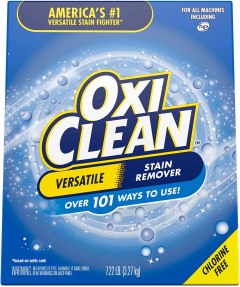
A stain remover with a wide range of uses even beyond clothes.
Can be used as a pre-treater for tough stains and in your regular washing machine (including high-efficiency machines). Can also be used to clean carpets, floors, and other hard surfaces.
Some buyers said this fades colors in clothing.
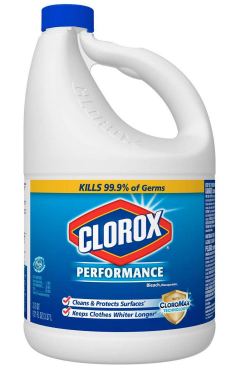
A go-to bleach designed for high-efficiency washing machines but useful all over the house.
Thick consistency compared to ordinary bleach. More concentrated than some bleaches for extra cleaning power. Ideal for HE washing machines. Easy-grip handle to minimize spills.
Does not have much of a scent.
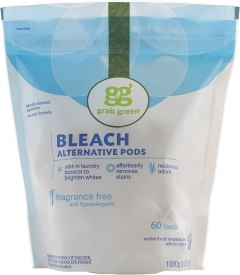
For those who seek a nontoxic, organic alternative to chlorine bleach, these inexpensive pods come recommended by our expert.
Works especially well on color loads. Safe, organic alternative to chemical bleach. Boosts detergent power during wash.
Pods do not always dissolve completely. Not as effective as actual bleach on certain stains. Some report it has an unpleasant fish-like odor.
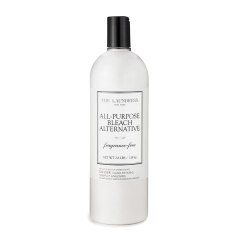
Our expert likes the versatility of this product and that it can be used to remove yellowing from white clothing.
Gentle bleaching on clothing; not a harsh chemical action. Clothes retain pleasant fragrance. Can be used as a multipurpose cleaning solution.
Granules may not dissolve completely. Dry product stored in a package for liquids. Challenging to use in HE washing machines.
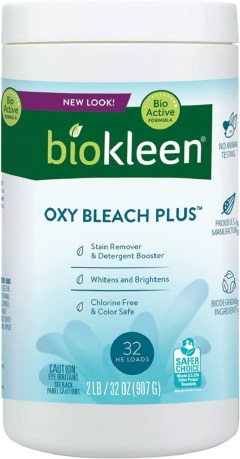
This eco-friendly product is great for use on carpet, grout, decking, upholstery, and laundry, according to our expert.
Free of ammonia, phosphates, chlorine, and artificial fragrances. Boosts detergent in washes for more vibrant color. Biodegradable and free of animal testing. Excellent for grout and tile.
Some users complain it does not remove stains on white clothes quickly.

We recommend these products based on an intensive research process that's designed to cut through the noise and find the top products in this space. Guided by experts, we spend hours looking into the factors that matter, to bring you these selections.

Whether you want to get that dingy white shirt back to its original, pristine vibrancy or kill all of the nasty germs that are residing in your toilet bowl, the product you reach for is bleach. Bleach is a versatile disinfectant and whitener that can be used in the bathroom, laundry room, kitchen, and more.
However, bleach is a rather generic term. It can mean something slightly different to individuals and manufacturers. Depending on your needs, bleach can come as a liquid, gel, powder, or even tablet. It can be packaged as a concentrate that must be diluted before using, or it can be found as an additive in laundry detergent.
If you want to learn more about bleach, what it can be used for, and what it shouldn't be used for, this is the article for you.

All bleach works by oxidizing stains and germs. However, there are two main ways that bleach can accomplish this task, and each has its pros and cons. Therefore, the first decision you must make when looking for the bleach you need is whether you want chlorine bleach or non-chlorine bleach.
Chlorine bleach: When you say "bleach," most people think of chlorine bleach. This type of bleach contains sodium hypochlorite. It is potent. If you want to clean those grass-stained white socks or disinfect the surfaces in your bathroom, this is what you want.
On the downside — it is potent. Chlorine bleach can weaken or destroy silk, wool, and other delicate fabrics. It will also turn everything white, even items that you might not want to be white. When using chlorine bleach, you want to wear personal protective equipment (see the Accessories section below) and work in a well-ventilated area.
Non-chlorine bleach: This type of bleach gets the job done by using hydrogen peroxide instead of the more corrosive sodium hypochlorite. Non-chlorine bleach can get rid of stains, it’s safe for use on colors, and it also works as a disinfectant. Some even believe it has less negative impact on the environment. The downside of using non-chlorine bleach is that it simply isn’t as potent, and it may not be adequate for use in every situation.
Another important factor to consider when purchasing bleach is how it comes and how it is dispensed.
Liquid concentrate: This is the form that most people think of when they purchase bleach: a jug of concentrated liquid. This type of bleach is highly corrosive and must be diluted before use. You will need to read the label to understand how to safely use this product.
Tablets: Tablets are a highly concentrated form of bleach. You can use them in much the same way that you would use liquid bleach. They can be added to a laundry load, dissolved in the toilet for sanitizing purposes, or added to water to make a potent disinfectant solution.
Pods/powder/crystals: Like tablets, this type of bleach is a solid. It may come in packets or pods that you drop into your washing machine or it may come in a container so you can sprinkle the bleach into a toilet. Additionally, the powder can be added to water to make a disinfectant solution that is used to clean floors and other surfaces.
Gels: The main purpose of purchasing bleach in gel form is so it doesn't splash. It’s used in situations where a controlled application is required.
Pens: A bleach pen is a portable stain-removing tool that can be used with great precision. It functions like a magic marker and can be used on household surfaces as well as laundry items.
Spray: Some manufacturers make a cleaning and disinfecting solution that can be sprayed directly on surfaces. While these sprays may still irritate skin and are not recommended for use around individuals with asthma, bleach is present in much lower concentrations than you would find in other bleach products.
Wipes: While these may sound like a great, convenient option, bleach is not a substance you want to touch with your bare hands. Consequently, wipes are more along the lines of hand sanitizer because they do not contain bleach.

The following are a few other important factors you need to consider before purchasing bleach.
Bleach is only good for 12 months. If possible, be sure to check the expiration date before purchasing.
Regular strength bleach is typically 5.25% sodium hypochlorite. For the toughest jobs, however, you may want to consider a stronger bleach that contains 6% sodium hypochlorite.
As you might expect, scented bleach has a pleasant fragrance. It’s used to help make clothes smell fresher. However, scented bleach does not usually disinfect. Be sure to read the label to be certain the product will do everything you need it to do.
If you feel uncomfortable using bleach for any reason, you can purchase an all-natural bleach-free alternative. While a bleach-free alternative won't be as potent or as effective in every situation, it is a viable option for many.
Bleach can irritate your eyes, nose, lungs, and skin. Before using bleach, it's best to put on some personal protective equipment. Besides covering your skin with appropriate clothing, consider wearing gloves, eye protection, and even a mask.
Gloves: Tusko Products Household Gloves
These durable chemical- and cut-resistant nitrile gloves are an impressive 15 mils thick and have a slip-resistant texture. The inner lining is odor resistant and the gloves are guaranteed to be free of both latex and vinyl.
Eye protection: Honeywell Safety Goggles
These safety goggles have an anti-fog coating and are designed to protect your eyes from accidental chemical splashing. The soft elastomer body allows a comfortable and secure gap-free fit even over glasses.
Mask: 3M Household Cleanser Odor Respirator Mask
This mask is specifically designed to be worn while using products such as toilet bowl cleaner, oven cleaner, or bleach. The carbon layer helps reduce odors while filtering out at least 95% of solid and liquid aerosols.
If you're looking for the best value, a bottle of concentrated liquid bleach is your best bet. A 64-ounce bottle is usually available for $4 to $8.
A 24-ounce to 30-ounce bottle of bleach gel or toilet cleanser bleach is also around $4 to $8.
For around $8 to $10, you can get a 24-ounce container of bleach crystals or powder.
Be careful when considering packets or pods because these items may be priced at $15 to $20 but only handle a fraction of the chores that a liquid concentrate does.
While chlorine bleach can be an incredible tool that is used for disinfecting and whitening, it should not be used in every situation. In fact, it can be extremely dangerous — to the point of deadly — to misuse chlorine bleach. The following are some safety guidelines to follow when using chlorine bleach.
Do not mix chlorine bleach with anything but water. Rather than trying to keep track of the items that you can't mix with chlorine bleach, it’s far easier to remember what you can mix with it: water. In most instances, laundry detergent is perfectly fine as well, but be certain to thoroughly read all labels first.
Do not use chlorine bleach without wearing protection. Chlorine bleach can irritate your skin, burn your eyes, and damage your lungs. Because of this, you always want to work in a well-ventilated area and wear personal protective equipment such as gloves, safety glasses, and mask.
Do not use chlorine bleach on wood, stone, or metal. If you read the label on your chlorine bleach container, you will find the words "not for use on porous surfaces" (or something similar). Wood and stone are porous. Also, chlorine bleach works by oxidizing. This means, using chlorine bleach on metal may corrode the metal. When using chlorine bleach, be sure to keep it away from stainless steel sinks and other metals.
Do not use chlorine bleach on mold. Although many believe this to be the best way to get rid of mold, OSHA specifically advises against using chlorine bleach to kill mold. Using chlorine bleach can not only damage the material on which the mold is growing, but it could create conditions that are even better suited for mold growth
Do not use chlorine bleach on food: When cleaning food, the idea is to get the chemicals off, not add more. Rinse fresh produce thoroughly under cold water to clean it. The best way to keep your food safe is to store it properly and cook it to safe temperatures.

A. Although the average person considers bleach to be a cleaner, that's not what bleach actually is. If your hands get dirty while working in the yard, you wash them with soap and water. If you have harmful germs on your hands, you apply hand sanitizer and let it dry — you don't use hand sanitizer to scrub away dirt. Bleach is like hand sanitizer: you apply it to a surface and let it dry, you don't use it to scrub away dirt. Additionally, bleach has whitening properties that can be used in a variety of situations. In short, bleach is a sanitizer and a whitener, but it is not a cleaner.
A. Most people use bleach to whiten clothes and remove stains. However, bleach is also a powerful disinfectant that is most often used in the bathroom. Bleach can also be used to clean nonporous surfaces in the kitchen.
A. Chlorine bleach doesn't actually "remove" a stain. Without getting too technical, the chemical reaction that takes place when chlorine bleach hits a stain breaks the light-absorbing bonds between atoms. Objects that don’t absorb light appear white to our eyes. The effect is the stain appears to have disappeared, but in reality, the stain is now white, so you just don't notice it anymore.
Get emails you’ll love.
Learn about the products you’re wondering if you should buy and get advice on using your latest purchases.
